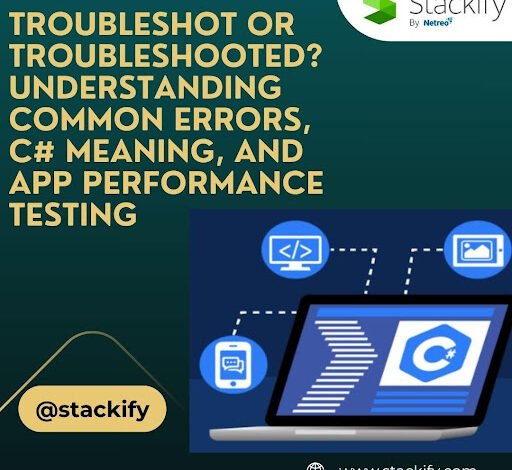
When it comes to technical writing and communicating effectively with developers, clarity and accuracy are key. Whether you are new to programming or an experienced developer, it is essential to understand terms and concepts that can boost your work performance. In this blog, we will discuss three important topics that developers often encounter:
- The confusion around the terms “troubleshot” and “troubleshooted”
- The meaning of C# (C-Sharp) and its relevance in modern programming
- App performance testing—what it is, why it matters, and the tools used to optimize performance.
Troubleshot or Troubleshooted?
Troubleshot or Troubleshooted As developers, you’ve probably found yourself debugging code or resolving system issues. This process is commonly referred to as “troubleshooting.” However, there is often confusion about the past tense of this word: should it be “troubleshot” or “troubleshooted”? Let’s settle this once and for all.
Correct Past Tense: Troubleshot
The correct past tense of “troubleshoot” is “troubleshot.” According to dictionaries and linguistic authorities, irregular verbs such as “shoot” (in this case, embedded in “troubleshoot”) follow a specific conjugation pattern, where “shot” becomes the past tense. Hence, when describing past troubleshooting efforts, the word to use is “troubleshot.”
For example:
- “I troubleshot the database issue yesterday.”
- “The IT team troubleshot the server problems last week.”
Common Misconception: Troubleshooted
While “troubleshooted” might sound more natural to some, it is incorrect grammatically. Nevertheless, this incorrect form often appears in informal discussions or online forums due to how the word is commonly used. It’s important for developers and technical writers to use the correct terminology, especially in professional or formal settings.
To clarify:
- Correct: “Yesterday, I troubleshot the network problem.”
- Incorrect: “Yesterday, I troubleshooted the network problem.”
The next time you describe how you resolved a technical issue, make sure you are using “troubleshot.”
C# Meaning: A Quick Guide for Developers
C# (pronounced “C-Sharp”) is a powerful, modern, object-oriented programming language developed by Microsoft. It plays a vital role in the development of web applications, desktop software, mobile apps, games, and more. If you’re new to programming or just starting out with C#, understanding its core meaning and purpose can help you become a more effective developer.
What is C#?
C# was introduced by Microsoft in the early 2000s as part of the .NET framework, a software development platform that provides tools and libraries for building various types of applications. C# has become one of the most popular languages due to its versatility and the vast ecosystem that surrounds it. It is particularly favored in enterprise environments, thanks to its deep integration with Microsoft technologies.
Why Choose C#?
C# is widely used for developing Windows applications, server-side applications, and game development (with Unity). Here are some key features of C# that make it an attractive language:
- Simplicity: C# syntax is easy to read and write, which makes it accessible to beginners while still powerful enough for experienced developers.
- Object-Oriented: C# supports all four principles of object-oriented programming (OOP): encapsulation, inheritance, abstraction, and polymorphism.
- Cross-Platform: Thanks to .NET Core and .NET 5/6, C# applications can now be built for multiple platforms (Windows, macOS, Linux).
- Rich Library Support: C# comes with an extensive collection of libraries that facilitate rapid development, from networking to security to database management.
- Community and Support: Microsoft’s commitment to C# ensures long-term support, and the developer community for C# is vast, with a wealth of resources, forums, and tutorials available online.
Use Cases of C#
- Web Applications: C# is commonly used with ASP.NET to create dynamic, data-driven websites and web APIs.
- Desktop Software: Using frameworks like WPF and WinForms, C# is ideal for creating robust desktop applications.
- Game Development: C# is the primary language for Unity, one of the most popular game engines, making it perfect for creating 2D, 3D, VR, and AR games.
- Mobile Apps: With Xamarin, a .NET framework for mobile development, C# allows developers to build cross-platform mobile apps for Android and iOS.
Whether you are interested in web, desktop, or game development, C# offers a reliable, scalable, and efficient solution.
App Performance Testing: The Key to Delivering Fast and Reliable Software
One of the most critical aspects of software development is app performance testing. In today’s fast-paced digital world, users expect apps to be responsive and reliable. Poorly performing apps can lead to user frustration, revenue loss, and reputational damage. That’s why performance testing is essential to ensure your application meets performance expectations under various conditions.
What is App Performance Testing?
App performance testing is the process of evaluating how an application behaves under specific conditions. This type of testing helps developers identify performance bottlenecks, optimize resource usage, and ensure the app can handle anticipated traffic loads.
Why is Performance Testing Important?
The performance of an app directly impacts the user experience. If an app takes too long to load, consumes too much memory, or crashes under high loads, users are likely to abandon it. Effective performance testing helps you:
- Ensure stability: By simulating different user loads and environments, performance testing allows you to identify potential issues before they affect real users.
- Optimize speed: Testing helps identify inefficiencies in the code or architecture that slow down your application.
- Enhance scalability: By testing how your app performs under increasing load, you can ensure it scales properly as your user base grows.
- Boost user satisfaction: Fast, reliable apps lead to higher user satisfaction and engagement.
Types of Performance Testing
- Load Testing: Simulates multiple users interacting with the app at the same time to see how it performs under normal and peak load conditions.
- Stress Testing: Pushes the app beyond its expected limits to see how it behaves when it’s pushed to the breaking point.
- Endurance Testing: Tests the app’s ability to perform over an extended period to identify memory leaks or performance degradation over time.
- Spike Testing: Tests how the app responds to sudden, dramatic increases in load.
- Scalability Testing: Ensures the app can scale efficiently when resources (e.g., CPU, memory) are increased.
Tools for App Performance Testing
There are various tools available to help developers carry out performance testing efficiently. Here are some of the top ones:
- Apache JMeter: An open-source tool for load testing web applications. It can simulate heavy loads on a server, network, or object to test its strength and analyze overall performance.
- LoadRunner: A popular performance testing tool that supports testing a wide range of application types, including web, mobile, and cloud.
- Gatling: A powerful open-source performance testing tool designed for testing web applications. It is particularly known for its ability to handle large-scale testing with ease.
- BlazeMeter: A continuous testing platform that enables performance testing of APIs, mobile apps, and websites.
- New Relic: A comprehensive application performance monitoring (APM) tool that tracks application behavior in real-time to help identify performance bottlenecks.
Conclusion
In this blog, we’ve covered three essential topics for developers: the correct past tense of “troubleshoot,” the meaning and significance of C#, and the importance of app performance testing. Understanding these concepts can make a significant difference in your development process. By using the correct terminology, learning C#, and ensuring your apps perform optimally, you’ll be well on your way to becoming a more efficient and knowledgeable developer.



